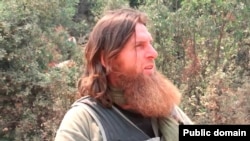Over the weekend, reports emerged that Russian forces are expanding a military airport in Syria's coastal province of Latakia.
This comes amid more reports of a Russian military buildup near Latakia.
Two weeks before these reports broke, Life News, a tabloid-style Russian website with links to the security services, carried a story that appears to set the scene for these developments, warning of the threat posed by the Islamic State (IS) group in Latakia.
And in an emotional appeal to its Russian readers, it frames the "war on terror" in Latakia as an extension of Russia's own struggle against Islamic militancy in the North Caucasus.
Life News claimed IS has dispatched "natives of [Russia's North] Caucasus republics" to Latakia. "Among them are militants who took part in actions against the Russian Army during the Chechen campaigns, and then fled from Russia," it said. "Their skills aid in the development and implementation of operations in the Latakia heights."
Half-Truths
The Life News report is based on elements of truth that have been misinterpreted -- or twisted -- to tell a particular narrative.
It is true that there are several groups of Chechen militants based in the forests of Latakia (though Life News only refers to one). And three of those groups have leaders and fighters who are known to have fought against Russian forces as part of the Islamist insurgency in the North Caucasus.
Indeed, North Caucasus militants in Syria like to say that Latakia is "Syria's Caucasus." They joke that fighters feel at home there, because they can hide out in the forests and mountains.
The catch is that none of the Latakia Chechen groups is connected with IS.
The three main Chechen-led groups in the Latakia mountains are Ajnad al-Kavkaz (Soldiers of the Caucasus), Junud al-Sham (Soldiers of Syria), and a much smaller group, Tarkhan's Jamaat.
Ajnad al-Kavkaz is led by Abdul-Hakim al-Shishani (Hamzat Azhiyev), who is believed to be from Prigorodnoye, a town southeast of the Chechen capital, Grozny.
Azhiyev came to Syria via Turkey after losing several fingers from his left hand in an injury sustained during the armed insurgency against Russian government forces in the North Caucasus.
A media activist with Azhiyev's group told RFE/RL earlier this year that Azhiyev had not sworn an oath of allegiance to the North Caucasus militant group the Caucasus Emirate, but would fight alongside them if he were to return to Chechnya.
Junud al-Sham is led by the veteran ethnic Chechen militant Muslim al-Shishani (Murad Margoshvili) from Georgia's Pankisi Gorge, who fought alongside Arab foreign fighters in Chechnya.
Tarkhan's Jamaat is a much smaller group of fighters loyal to Chechen militant Tarkhan Ismailovich Gaziyev.
All three fight against Syrian President Bashar al-Assad's forces alongside Syrian Al-Qaeda affiliate Jabhat al-Nusra and Ahrar al-Sham -- factions that are opposed to IS.
Why Create An 'IS Threat' In Latakia?
The Life News claim that IS poses a threat in Latakia is part of Moscow's "grand narrative" about the Syrian conflict, according to which Assad is engaged in a war against extremist groups funded by external enemies.
Moscow has insisted that only the Syrian Army is capable of opposing these groups, chiefly IS. "Excluding the Syrian Army from the fight against IS is absurd," Russian Foreign Minister Sergei Lavrov said on September 13.
Life News makes another assertion that is based on distorted facts but which reveals a larger truth about why Moscow is helping Assad shore up his military capabilities in Latakia.
Controlling the mountains of Latakia is "not the terrorists' goal," Life News says. Instead, the Chechen-led groups have advanced into Latakia to "advance from Idlib Province...and advance into Hama Province."
This claim is misleading. All three Chechen-led militant groups in Latakia have been entrenched there for well over a year before they took part in the Idlib offensives.
What is true is the claim that rebels from Idlib could advance on Latakia. That is a very real fear for Assad (and Moscow).
A key loyalist bastion, Latakia is the home of numerous Syrian government officials -- including Assad himself. And so far, although there have been Islamist rebel offensives here -- against the Armenian town of Kessab in 2014, for example -- Syrian government supporters have by and large felt safe there.
But that is changing.
Since taking Idlib city in March, Nusra-led fighters including the Chechen groups have advanced toward Latakia. In April they took Jisr al-Shughour, on the road between Latakia city and Aleppo.
The current focus of the battle is the Al-Ghab plain, a strategic area between Latakia, Hama, and Idlib provinces, which connects Idlib with the Latakia mountains.
If the rebels advance past Al-Ghab, Assad is in serious trouble. He cannot afford to undertake a strategic retreat from his heartland of Latakia, a fact Russia understands all too well.
Ahead of any Russian military build-up in Latakia, it is therefore convenient for Life News to conflate the presence of Chechen militants in that province with the IS threat -- even if the threat to Assad's stronghold does not come from IS.
